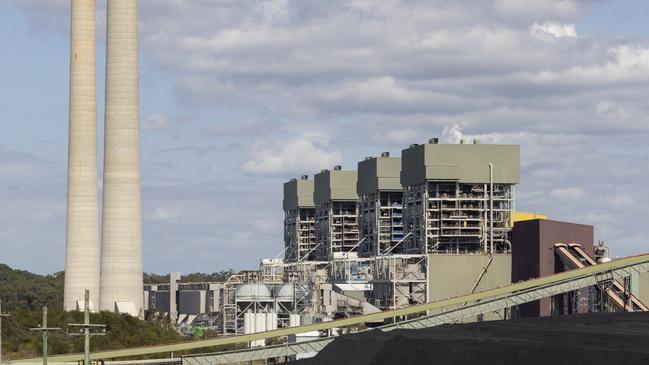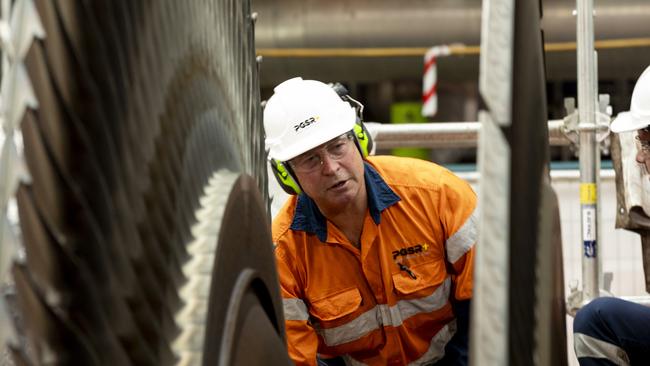Taxpayer pain to prop up ageing coal-fired power, Matt Kean says
Climate change tsar Matt Kean says government subsidies to keep ageing coal-fired power stations like Eraring open could encourage other generators to seek the same handouts.

Climate change tsar Matt Kean says government support to keep ageing coal-fired power stations like Eraring open could encourage a flurry of handouts to big generators and threaten to delay investment in renewables.
Mr Kean, the former NSW treasurer and energy minister who now heads the Climate Change Authority, said the NSW Labor government’s decision earlier this year to extend the life of Origin Energy’s giant Eraring power station by at least two years, at a cost of up to $225m per year, could create an unwelcome precedent and a “moral hazard” for taxpayers.
Mr Kean also took a swipe at proposals to build a nuclear power industry, saying it would take too long and was too costly.
“When you extend Eraring without giving certainty to the market, capital will sit on its hands,” Mr Kean told the Citi Australia & New Zealand Investment Conference on Wednesday. “We need to give more certainty to private capital, and that means being very clear with the market around the timings of the exits of plants.”
Mr Kean said governments should always be looking to give the “best deal to taxpayers and consumers.” “We don’t know what taxpayers are going to have to pay for the extension of Eraring and that creates a moral hazard that worries me.
“Does it mean that Energy Australia then comes to the government and says well, we’re going to pull (Mt) Piper (Power Station) out 10 years early, and you need to pay us a huge amount of rent? Does AGL then come to the government and say, well, you paid Origin, we will pull out Bayswater early unless you pay us?”
Mr Kean said he was a big supporter of more market mechanisms and more private capital as Australia moved to net zero. “As I keep saying to my friends that are climate sceptics or are pushing nuclear, you don’t need to believe in climate change to believe in capitalism,” he said.
He said the fact remained that 90 per cent of coal generation is coming out of the system and needed to be replaced quickly. Eraring was fully commissioned in 1984.

“It’s got nothing to do with climate change and everything to do with the fact this is old equipment that was built in the 70s and 80s, and it’s at end-of-life,” he said.
Mr Kean said every time Daniel Westerman, the head of the AEMO (Australian Energy Market Operator) “would flash up on my phone”: as NSW energy minister, he knew it was due to supply issues caused by ageing coal-fired power plants.
“It meant that he was warning me that there were shortages in supply and let me tell you, it wasn’t because there were too many renewables in the system,” Mr Kean said.
“It was never the renewables that caused Daniel Westerman to call me and say, minister, we may have to consider load shedding tonight.
“It was the fact that coal was becoming less reliable. A tube leak here, you know, a generator breakdown there. These were kind of more frequent events.
“We need to replace old technology with newer technology now, and obviously look to the future to see what’s coming on the horizon.”
Mr Kean said that while it was important to keep an eye on what was happening in the future on nuclear technologies, it would never replace renewables.
“Coal-fired power that has underpinned our economy is coming to the end of its technical life by 2035 so we need to get on with the task of replacing that generation capacity,” Mr Kean said. “The consistent advice of experts, including the CSIRO, is that the most affordable way is to have a system built on renewables, backed by batteries and firming technology. It’s the best way to keep reducing carbon emissions solutions on the road to net zero.”
Mr Kean said nuclear was old technology that had been around since the 50s and was “not coming down the cost curve.” “Quite frankly, you need to build a lot of redundancy into nuclear to ensure that you maintain the social licence, keep it safe and ensure that it works,” he said.
“So that means the cost of it is incredibly high.”

Mr Kean said the best example of a nuclear facility being built in a Western country is the Hinkley Point C project in Somerset, England, that has faced huge delays and cost overruns after planning started in 2007.
“That’s a project that is not going to deliver a single electron until 2028,” he said.
“Now, we can’t bet on a solution that can’t deliver an electron into the Australian electricity market for 20 years, when 90 per cent of our coal is coming out of the system in 10 years.
The cost of that plant was scheduled to be $5.5bn. Today, the cost by the time it’s finished is projected to be around $83bn.”




To join the conversation, please log in. Don't have an account? Register
Join the conversation, you are commenting as Logout